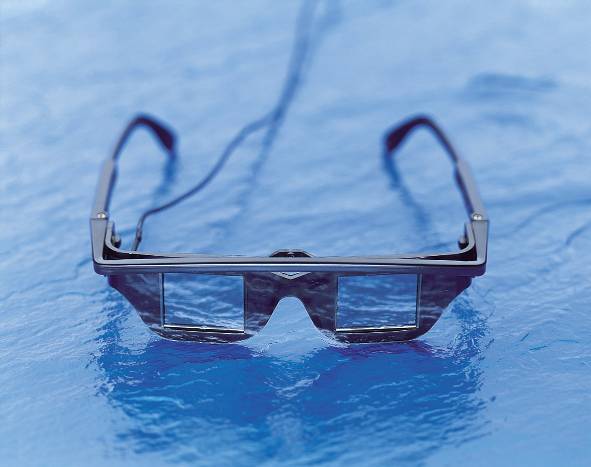
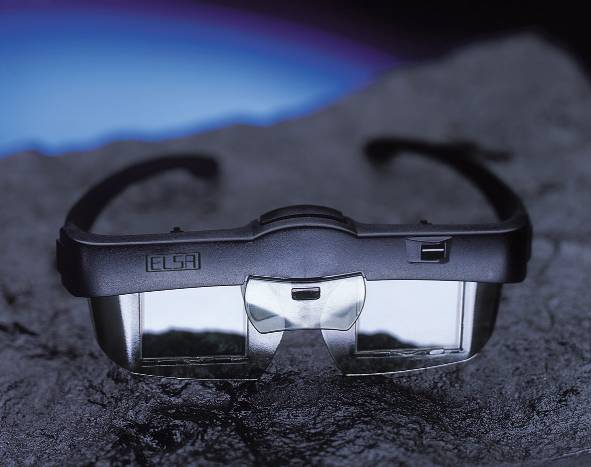
The unofficial ELSA 3D
Revelator page
Quick info:
The Revelator comes in two versions:
wired and wireless. LCD-panels, connectors, drivers & compatibility
are identical. Both versions feature a VESA compliant mini-DIN-3 stereo
connector.
In conjunction with an ELSA consumer
graphics board or most 3rd party TNT/TNT2-board they support any Direct3D
game or application in a quality unpredescented by any other system. The
Revelator Direct3D drivers deliver ultra-hi-res images to each eye. There
are no black interlace lines or cut-into-half resolutions. The refresh
rate goes from 50 Hz to at least 140 Hz fitting any taste and monitor.
The Dyna-Z logic in the driver adjusts the stereo depth dynamically throughout
the gameplay. No patches, no stereo-configs required!
The software page-flipping employed
by ELSA not only delivers compatibility with popular chipsets such as TNT2
combined with incredible image quality and great stereo-effects. It's also
the 'Achilles Heel' of the product. Just like grandpa LCD-BIOS it's vulnerable
to resource conflicts with sound-cards, joysticks and such. The Revelator
needs an IRQ - and uses it!!! If there are any conflicts or other 'heavy-IRQ-users'
in the system it may screw the stereo-mode.
Apart from the VESA-compliant DIN-3
connector the Revelator is a 100% proprietary system and NOT compatible
to anything else.
(ELSA, H3D, eyeSCREAM, Freedom wear,
i-3D and similar glasses are manufactured by Ilixco
and use the same IR-transmitter code though.)
The Revelator is a leap forward in terms
of quality and value-for-money. At the same time it makes several steps
back from the achievements Metabyte brought us with their brilliant eyeSCREAM
drivers.
What we need now is a driver which
combines the advantages of ELSA and Metabyte and sticks to the VESA-standard,
i.e. rock-solid hardware-page-flipping and DIN-3 connectors on glasses
AND boards! This is also a task for the chipset-developers. They have to
comply to the VESA-stereo-standard and put the required functions in -
or as my lawyer says: 'If it doesn't flip you musta' quit!'
NEW: Revelator
now supports TNT, TNT2 & TNT2-Ultra boards of all brands. Get the generic
driver at the german ELSA page. You have
to fill out the registration form.
NEW (Dec. 99):
The
latest beta drivers for ELSA's own TNT2-boards has native OpenGL support
now.
NEW (Dec. 99):
Added
troubleshooting section
This review isn't
intended for beginners. Please consult the Basics
and FAQ pages if questions arise.
This page was innitially released on July 10, 1999
last update: Dec. 30, 1999
Related Links:
official
ELSA site
Stereovision.net
Wicked3D review
H3D review
Revelator vs. eyeSCREAM
chart


Test configuration:
IDEK Iiyama Vision Master 17 monitor (86 kHz max. hor., 160 Hz max.
vert.)
Pro:
|
Con:
|
Glasses
|
Glasses
|
+ larger LCD-panels
than H3D/eyeSCREAM
+ high quality LCD-panels
wireless version:
+ same IR-code as H3D/eyeSCREAM
+ light
wired version:
+ extremely comfortable
+ extremely light (30 g)
+ inexpensive
+ adaptor for up to 4 glasses
available
|
- LCD-panels still
smaller than the competition
wireless version:
- loss of comfort and field
of view when used with prescribed glasses
wired version:
- loss of field of view
when used with prescribed glasses
|
Controller
|
Controller
|
+ VESA mini-DIN-3
connector
+ VGA-to-DIN-3 adaptor included
+ passive VGA-to-DIN-3 adaptor
has low impact on signal quality
+ power supply by VGA-board
(nice as long as you got power there, but turns into a 'con' if you don't)
|
- no H3D/eyeSCREAM
hardware compatibility (apart from IR-Code)
- no 3rd party software
support whatsoever (when used with ELSA consumer boards)
- there's no DIN-3 connector
on ELSA consumer boards, the adaptor has to be used
- VGA-to-DIN-3 adaptor not
suitable for non-ELSA boards
- shutters controlled by
proprietary software trigger (when used with ELSA consumer boards)
- synchronization problems:
dark stripe on bottom of screen (when used with adaptor)
- requires power over the
VGA-output, which some 3rd party boards doesn't provide (ASUS for example)
- uses DDC-pin of the VGA-out
for triggering the glasses which leads to incompatibility with certain
monitors
- no autosync or sync-doubler
functions
- no alternate-line and
avobe-below image-format support
- no H3D/eyeSCREAM drivers
support
|
Drivers (for
ELSA consumer boards only)
|
Drivers (for
ELSA consumer boards and a few 3rd party boards only)
|
+ choice of TNT,
TNT2, Banshee and Savage4Pro
+ NEW:
now supports many 3rd party TNT/TNT2 boards
+ NEW:
now supports OpenGL on ELSA-TNT2-boards
+ total refresh control
from 50 Hz up to 'blow-any-monitor'
+ almost perfect monitor
compatibility
+ may even work with some
HMDs' (field-sequential stereo on VGA-input)
+ no patches/stereo.cfg
files required
+ high software compatibility
- many titles which didn't run on eyeSCREAM now work
+ works with OpenGL and
Glide wrappers
+ best Direct3D support
ever (much better than eyeSCREAM)
+ good stereo effects
+ best image quality ever
+ no black interlace-lines
+ highest resolutions ever
- hungry for 1600x1200 per eye anyone?
+ uses full vertical resolution
per eye, i.e. all lines
+ uses almost full horizontal
resolution per eye
+ 32bit color support
+ fast - performace drain
just 20-30 %
+ fast switching between
mono/stereo
+ slightly lower ghosting
than usual
+ Dyna-Z adjusts depth dynamically
+ graphical representation
of depth information available during gameplay
+ many options available
during gameplay
+ driver stores your settings
and remembers to which game they belong to
+ in-screen/out-of-screen
control
+ monitor size control
+ eye-distance calculator
+ snapshot function
+ image viewer
|
- no native OpenGL
and Glide support
- no full horizontal resolution:
image becomes smaller with larger stereo separation (black border on the
left and right side)
- uses software page-flipping
with IRQ, like 'grandpa' LCD-BIOS
- vulnerable to resource
conflicts
- vulnerable to system performance
- slip-ups are possible
especially when used with force-feedback devices on joystick/MIDI-port
- no backward compatibility
with older systems
- no H3D/eyeSCREAM compatibility
- no DIN-3 jack on ELSA
consumer boards
- no 3rd party Banshee or
Savage4Pro support
- no Voodoo 2 or 3 support
- no resolution override
(as eyeSCREAM)
- no laser targeting (as
eyeSCREAM)
- no image viewing directly
from web-browser (like VR-Joy, EyeFX)
|
Like all shutterglasses the Revelator suffers from ghosting
and doesn't work with LCD-monitors and -projectors.
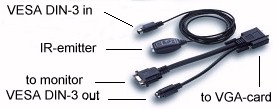
The IR-emitter and the wired glasses (VESA miniDIN-3)
The Revelator doesn't have a controller in the usual sense. It's just
a plain DIN-3 system.
There are two ways to connect them to the graphics board:
1) Just plug the emitter/glasses into a stereo ready workstation or
hi-end gfx-board with mini-DIN-3 stereo connector. There are adaptors for
other stereo-ready systems, i.e. DIN-5, DIN-7, DB9, 3.5 mm stereo jack,
but these are not delivered by ELSA.
2) Use the VGA-pass-through cable to connect the Revelator to one of
ELSA's consumer graphics boards, i.e. Erazor 2 or 3, Winner 2 or Victory
2. The VGA-pass-through adaptor isn't much more than a dumb cable. There's
no controller in it. It doesn't look for the VSync. It looks for a proprietary
signal on the DDC pin. Without the ELSA board BIOS and drivers it won't
work.
BTW the impact of the adaptor on the VGA-signal-quality is insignificant.
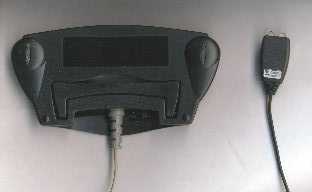
The H3D/eyeSCREAM-IR-emitter (left) compared to the small ELSA-IR-emitter
(right). Both use the same IR-code. The ELSA seems to do the job just as
good as the H3D. Heaven knows why H3D wasted so much plastic here. The
H3D had a IR-range switch for multiplayer matches in one room. I don't
know if it helped much.
Power
There is no external power supply. The wired glasses and the IR-emitter
are powered by the VGA-board in any case.
Check connection schemes on the NuVision
60GX pages to see the options for connecting a VESA DIN-3 system like
the Revelator to a stereo-ready workstation.
The ELSA board drivers deliver any refresh rate one could wish for.
So flicker isn't much of an issue as long as you got a hot monitor. I recommend
a monitor with 80+ kHz horizontal and 120+ Hz vertical range.

Revelator wired, the lightest and maybe most comfortable glasses
on the market
The 'wired' comes with two pairs of bows - soft and hard. The bows
are adjustable in length to fit any nose-ear distances.

The Revelator IR; similar to H3D, but the
LCD-panels are wider by 1 cm - Ahhhhh.... what a relieeeef!
under construction -
more comments on the glasses to be added later, check the pro-con
table for now
Please check the X-RAY Lab for a weight&size
comparison of various shutterglasses, including the Revelators.

The ELSA Revelator is by no means compatible with H3D/eyeSCREAM!!!
The Revelator has no auto-sync, no line-blanker, no sync-doubler - nothing!!!
The compatibility with other consumer systems is ZERO. As a VESA DIN-3
device it's compatible with CrystalEyes-Wired, CrystalEyes ENT and NuVision
60GX-SR.
It works with two kinds of graphics boards:
1) ELSA consumer boards (Erazor 2/3, Victory 2, Winner
2)
2) Boards with stereo-connector, i.e. DIN-3, DIN-5, DIN-7, DB9
and 3.5 mm. For all connectors apart from DIN-3 you'll have to look for
a proper adaptor.
Special stereo-drivers for your graphics card are obligatory. This
isn't in the hands of the glasses manufacturer. Ask your graphics hardware
vendor for stereo-driver support. There may be lacking driver support even
if there's a dedicated stereo-connector on the board!!! The ELSA Revelator
Direct3D drivers won't work on such boards.
...on ELSA consumer boards (Erazor 2/3, Victory 2, Winner 2)
The stereo driver for ELSA consumer boards supports all Direct3D titles
which deliver correct Z-axis information. It does a great job in that area.
There is no native support for OpenGL or Glide. The driver works with GL/Glide-to-D3D
wrappers, but performance may be weak here. When used with an ELSA consumer
board the Revelator won't support any other software or drivers, such as
LCD-BIOS, eyeSCREAM or H3D-native titles. The ELSA Direct3D stereo driver
is only available for ELSA consumer graphics boards!
...on 3rd party boards without stereo connector
Glasses won't work in any way!
...on 3rd party boards with stereo connector
On a board with stereo connector the Revelator is limited to proprietary
stereo software which runs on the board in question. Special drivers and
applications which utilize page-flipping and trigger the dedicated stereo-connector
of the graphics hardware are required. Only a special combination of stereo-ready
hardware, operating system, stereo-ready drivers, applications and plug-ins
will work.
Check the StereoGraphics
software list for professional titles. Look for programs compatible with
'CrystalEyes-Wired', since these are quite similar to the Revelator!!!
The universal ELSA Direct3D Stereo-Driver
|
The whole shutterglasses-market isn't about hardware. Only beginners
care about fancy design, wired vs. wireless and such. With a little experience
you will realize there's only one thing that matters: DRIVERS!
To make this clear: actually there's no such thing as a 'Revelator-driver'
to download or buy somewhere! The stereo-driver and the Revelator-trigger-driver
are from now on an integral part of the ELSA consumer VGA-board drivers.
So whoever uses such a board and new drivers has the Revelator stuff in
it.
What may be irritating is the fact that you won't see the Revelator-options
in the ELSA-properties after installation. The trick is to install the
Revelator image viewer which is available for download from ELSA. Although
the image-viewer doesn't contain any driver-logic, the installation of
it sets the parameter to display the Revelator Stereo 3D options in the
Display properties.
Sometimes users of various shutterglasses believe that the drivers only
work as long as the glasses are installed. This was true for stone-age
ISA-board systems like the 3D-Max. In newer systems like H3D, eyeSCREAM
or Revelator the driver can't sense the presence of the glasses. This is
important since it opens the possibility of using 3rd party glasses or
even HMDs with them.
These sections will be added later:
Game and Application Compatibility
under construction -
more comments to be added later, check the pro-con
table for now
Options & Features
under construction -
more comments to be added later, check the pro-con
table for now
Dyna-Z
under construction -
more comments to be added later, check the pro-con
table for now
IRQ & Co. - Resource Conflicts
under construction -
more comments to be added later, check the pro-con
table for now
Problem: Slipups/Lightning in the Flipping (on-screen
and glasses)
Cause: Revelator is triggered actively. An IRQ is used. Therefore
the system is vulnerable to resource conflicts & performance problems.
Fix:
- Assign an exclusive IRQ to your VGA-card in the BIOS PCI/AGP setup
- Use a low numbered (i.e. high priority) IRQ
- Try to disable as unused or less important IRQ-users
- Try to disable AGP-mode
- Try a lower resolution, refresh rate or color depth
- Disable your digital joystick, wheel, force-feedback device
Problem: Revelator flickers irregularly (glasses only) or monitor
goes blank
Cause: Revelator is triggered by the DDC-pin of the VGA-output,
which is also used for communication with certain monitors.
Fix:
- Build a VGA-to-VGA adaptor and cut off the DDC-line
- Use other monitor
- Use some other system, which is Revelator-driver-compatible, i.e.
Eye3D, VR-Joy, EyeFX, 60GX-NSR, AnotherI's, etc.
Problem: Power supply for Revelator missing on
your VGA-output (for example on ASUS-VGA-boards)
Fix:
- Build a VGA-to-VGA adaptor and put 5V voltage to pin 9 from external
source
- Build a real VGA-pass-through controller for your Revelator - see
homebrew
section
- Use some other system, which is Revelator-driver-compatible, i.e.
Eye3D, VR-Joy, EyeFX, 60GX-NSR, AnotherI's, etc.
How to use other boards, glasses and even HMDs
with
the ELSA drivers
|
Boards from other manufacturers:
It has been shown that it's possible to turn 3rd party VGA-boards with
similar hardware into ELSA-boards by flashing the ELSA-BIOS into them.
(Visit stereovision.net for the details.) Thereafter the ELSA-driver and
the Revelator glasses will work. Warning: You may fail! You will loose
the special features of your board! You will loose guarantee! Noone will
grant you support - except for the internet community.
Does it make sense? Well, yes if
you already own a new board and don't wan't to switch for any reason. Otherwise
I would recommend to go for an original ELSA board. That's easier and saver.
Glasses from other manufacturers:
What the ELSA boards and drivers deliver is pure full-frame, full-resolution
page-flipping, also known as field-sequential format. There are many shutterglasses
on the market which are just checking the vertical sync signal on the VGA-output
to synchronize the glasses.

ELSA-compatible systems:
VR-Joy
i-Art VirtualEyes
Tetratel EyeFX
Another I's
NuVision 60GX-NSR
CyberStuff Cyber3DVisor (!?)
3DTV stereo driver model-3000 (among other 3DTV models)
APEC VR97
ASUS-glasses (?)
homebrew VGA-PT or SD

ELSA-incompatible systems:
H3D (color code missing)
eyeSCREAM (color code missing)
VRSurfer (requires a VGA-signal with interlace-timing. I checked it - No
go!)
all parallel and serial port systems, e.g. 3D-SPEX, Cyberboy (port not
triggered by ELSA drivers)
3D-Max and other ISA-board systems (board not triggered by ELSA drivers)
Does it make sense? Well the
ELSA glasses are some of the best and also some of the cheapest on the
market. If you don't own any glasses yet they are the best choice for the
ELSA drivers. If you're looking for some king-of-compatibility glasses
which also serve other purposes than D3D-gaming you may choose something
like the NuVision 60GX-NSR, VR-Joy or EyeFX as a derivate. The resulting
quality of synchronization varies. If the sync isn't good you may see dark
borders on the top or bottom of the screen. The Revelator itself surprisingly
doesn't shine in this diszipline. The 60GX works flawlessly with the ELSA
board here.
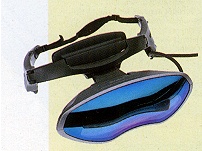
HMDs/VR-helmets
Since the ELSA drivers deliver field-sequential stereo-format at any
refresh rate it should be possible to use a compliant HMD with them.
This would require a HMD which accepts field-sequential stereo on the
VGA-input. By far the most HMD don't have that option. Most consumer HMDs
accept field-sequential stereo on the Video-input only. Professional HMD
on the other side usually require two seperate synchronized VGA-signals.
(BTW the new Matrox G400 with it's two outputs comes to mind here, but
there are no stereo drivers and - usually - the two outputs of the Matrox
are not synchronized. In fact Matrox is proud about the fact that they're
NOT synchronized!)
One HMD which may work with the ELSA-boards and drivers in stereoscopic
3D is the Sony Glasstron LDI-D100BE. The second hottest candidate for ELSA-compatibility
is the new VFX-3D, but I'm really not shure yet.
Since so many HMDs accept field-sequential stereo on the composite-video
or the S-video input the second best idea would be to connect them to the
TV-out of an ELSA board. Well I experimented a bit with the Erazor III
to get the stereo-information out of the TV-output undamaged. I failed,
but I used a very early board-version and driver, which was different from
the retail-version. I also didn't invest too many time in this. There is
still hope, but I wouldn't count on it. BTW I find the thought of connecting
an expensive HMD and a high-quality VGA-board via a sucking PAL/NTSC compliant
video-connection distgusting! It hurts image quality.
H3D/eyeSCREAM glasses and ELSA boards
- does it work?
|
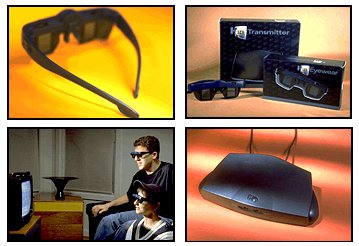
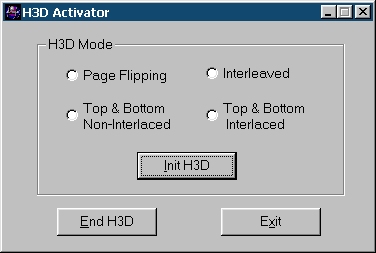
The H3D-Activator - a great tool - but not much help for the ELSA-drivers
Does it work? - Basically the answer is NO!
If you own some H3D/Wicked3D glasses you may wonder if they'll work
on the ELSA boards using Ghazalis
H3D-Activator.
Well they'll work using the Activator in Page-Flipping mode, but there
are several problems:
- there must be no change in graphics mode after using the Activator
or the glasses will drop out of
stereo-mode; many games use different modes for menues and game, so
there's a big problem
- if there's only one tiny slipup in the page-flipping the glasses
may show a reversed picture; this really can
happen, in this case you should hit the ELSA-stereo on/off hotkey until
you catch the right side again
- the original ELSA-Revelator glasses work under way higher resolutions
and refresh rates. I tried to put the
H3D/Wicked3D into page-flipping mode under 1024*768@hi-color@100 Hz
- no use.
- what we need would be a stay-resident hot-key controlled version
of the H3D-Activator which can be started from within the game
Here's my recommendation: If you're interested in the ELSA boards or
already own one, get the original
wireless Revelator IR glasses. The Revelator glasses will listen to
the H3D-IR-emitter and vice versa. So you
have the best of both worlds controller-and-driver-wise and you and
a friend can always use the two glasses
simultaniously.
BTW the controller/emitter of the Revelator won't work on current Wicked3D
boards and drivers, since it lacks
the required sync-doubler circuitry!
Special thanks to ELSA
for their support


Please consult the Shutterglasses
Comparison
Chart for a complete market-overview.
|
Brand and product names are trademarks or registered trademarks
of their respective holders.
The author can not guarantee the accuracy or topicality of the information
given on this page.
Christoph Bungert, Germany .










